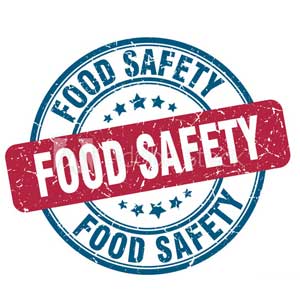Food that has been out of temperature for more than 4 hours may cause illness. Discard all spoiled food to avoid potential health risk.
Take special care in handling potentially hazardous food (PHF). PHF is moist, perishable food in and on which bacteria can grow. PHF must be maintained at a temperature below 41° F in your refrigerator and below 0° F degrees in your freezer.
If your home was impacted by a power outage, special considerations are necessary to ensure the safety of food in refrigerators or freezers.
- When the power goes out, keep refrigerator and freezer doors closed as much as possible.
- Check for signs of power outage such as liquid or refrozen meat juices, soft or melted ice cream.
- Discard any food that has an unusual color, odor, or texture.
- Discard perishable foods (including meat, poultry, fish, eggs and leftovers) in your refrigerator when the power has been off for 4 hours or more.
- Thawed food that contains ice crystals can be refrozen or cooked. Freezers, if left unopened and full during a power outage, will keep food safe for 48 hours (24 hours if half full).
- Reheating food that has become contaminated will not make it safe!
- When in doubt, throw it out!
Disposal of food
- Discard spoiled food in the appropriate refuse bin.
- To discard large volumes of food, contact your refuse disposal company for expedited service
- Whole produce may not need to be discarded. Cut produce needs to be discarded.
Additional Information is available at:
- U.S. Department of Agriculture (USDA) Food Safety and Inspection Service
- U.S. Food and Drug Administration (FDA)
Food safety for retail food facilities during power outages
Food facility operators must take the necessary steps to protect consumers from unsafe food before, during and immediately after power outages. Sonoma County Environmental Health recommends that food retailers develop a plan and obtain necessary supplies before the need arises.
Food operators should take special care in handling potentially hazardous foods (PHF). PHF are moist, perishable foods in and on which bacteria can grow. PHF require temperature control and must be held at, below 41°F, or above 135°F.
When there is an outage
Maintain cold potentially hazardous foods
- Keep refrigerator and freezer doors closed as much as possible.
- If practical, group packages of cold food together to reduce heat gain.
- Cover open refrigerated and frozen food cases, especially vertical displays.
- Use a generator to keep refrigerators and freezers in operation.
- Use dry ice or ice inside of refrigerators or freezers.
- Store food in a refrigerated truck.
- If available, relocate food to another permitted food facility.
- If necessary, use combination of dry ice and generator to maintain temperature of 41°F.
Caution: The use of dry ice may result in unsafe build-up of CO2 (Carbon Dioxide).
*Food taken to a private residence may not be returned to the facility*
Hot potentially hazardous foods
- Consider going to a limited menu to effectively maintain proper temperatures.
- Maintain hot foods above 135°F.
Important record keeping
- Note the time at which the power outage begins.
- Use a thermometer to monitor food temperatures and maintain a temperature log.
- Check temperatures every 4 hours.
Discontinue food preparation if any of the following conditions exist
- Inability to properly wash, rinse and sanitize utensils.
- Inoperative hood ventilation and make-up air supply systems.
- Lack of sufficient light in food preparation areas to allow for safe food preparation and cleaning and sanitizing of food contact surfaces.
- No hot water, inadequate water pressure.
When power is restored
Prior to resuming food preparation and/or sale of PHF, verify the following:
- Electricity and gas services have been restored.
- All circuit breakers have been properly reset as needed.
- All equipment and facilities are operating properly, including: lighting, refrigeration, hot holding, ventilation, and toilet facilities.
- Hot (minimum 120°F, except hand washing 100-108°F) and cold potable water, under pressure for hand washing and proper dishwashing.
- Maintain receipts/invoices of foods purchased after power has been restored.
Identify PHF that may have been in the temperature danger zone. Check the internal food temperatures.
PHF that has exceeded 50°F must be discarded.
Disposal of food
- If it is determined that food must be discarded, document the type and amount of food and the reason for disposal for records purposes.
- Discard small volumes in the appropriate refuse bin.
- To discard large volumes of food, contact your refuse disposal company or your local landfill operator for disposal instructions/expedited service.
- Non-PHF foods, such as whole produce, may not need to be discarded.
- If there are any questions regarding the safety of specific foods, contact Environmental Health.
When In Doubt, Throw It Out!
Questions
Contact Sonoma County Environmental Health Staff at (707) 565-6565 during normal working hours, 8:00 AM to 4:00 PM, Monday through Friday.
Additional information
Find PG&E information and learn more about what to do before, during, and after a power interruption.

